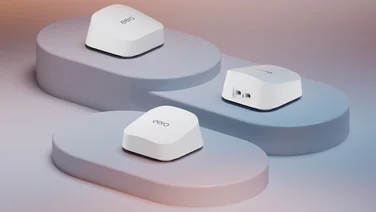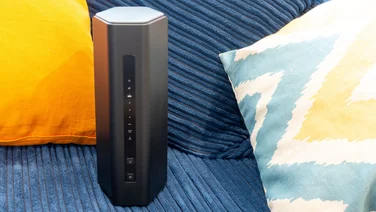To help us provide you with free impartial advice, we may earn a commission if you buy through links on our site. Learn more

Wi-Fi 7 is the latest generation of wireless technology, superseding the previous version, Wi-Fi 6E. It’s a huge improvement on any Wi-Fi technology that’s come before, and even has a few new tricks up its sleeve. But more on those later.
The Wi-Fi 7 standard has been out for quite a while, but was only finally certified in January 2024 by the Wi-Fi Alliance. This also means that Wi-Fi 7 equipment has already started to go on sale, so you might be curious about this new tech and whether you should buy it.
READ NEXT: Best broadband
What’s in a name?
If you haven’t been keeping tabs on networking nomenclature (and who could blame you?) then you might have missed the moment back in 2018 when the Wi-Fi alliance decided to simplify the way that Wi-Fi standards were named.
Initially Wi-Fi was named using an IEEE (Institute of Electrical and Electronics Engineers) code such as 802.11n or 802.11ac. However, since Wi-Fi is now something everyone uses and not just number-loving nerdy types, a rebrand was needed – so we now have the more simplistic-sounding “Wi-Fi 7” as the latest generation of the technology.
You’d think that Wi-Fi 6 would be the immediate predecessor, but actually there’s a half-step generation known as Wi-Fi 6E, which was quite a bit better, but not fundamentally new. (In case you’re curious, Wi-Fi 7 is IEEE 802.11be.)
READ NEXT: Best Wi-Fi extenders
Future-proofed for speed
Wi-Fi 7 is fast, like, really fast. When it comes to pure speed our recommendation has always been that Ethernet is the gold standard, but Wi-Fi 7 promises to be a true competitor for wired connections. At least when it comes to raw speed.
On paper, Wi-Fi 7 is rated for up to 46Gbits/sec (gigabits per second), which is faster than USB 4 v1 with its maximum transfer speed of 40Gbits/sec. Of course, in the real world, outside of a testing lab, actual Wi-Fi speeds never quite reach what’s promised. However, with gigabit Ethernet only now starting to become mainstream, and 10Gbits/sec fibre internet just entering the early adoption phase in some parts of the world, Wi-Fi 7 has a lot of future-proofing built in.

For comparison, Wi-Fi 5, which is quite common now and what most people likely have in their homes, has a theoretical speed limit of 3.5Gbits/sec, with real-world performance usually coming closer to 1Gbit/sec in most circumstances. Wi-Fi 6 pushed that speed to around 9.6Gbits/sec.
READ NEXT: Best mesh Wi-Fi routers
What makes Wi-Fi 7 so fast?
While we don’t want to get into the finer technical details of what makes Wi-Fi 7 tick, you’re probably curious to find out how this new standard can be so much faster than what’s come before.
First, like Wi-Fi 6E, Wi-Fi 7 added a new frequency band to the roster. Wi-Fi 6 and Wi-Fi 5 operate in the 2.4GHz and 5GHz bands, but Wi-Fi 6E and 7 have access to the 6GHz band as well. However, Wi-Fi 7 sets itself apart by having 320MHz worth of frequency bandwidth in the 6GHz band available for data transmission, compared to the 160MHz of Wi-Fi 6E. Theoretically doubling the bandwidth. In layman’s terms, this new generation of Wi-Fi incorporates ultra-wide 320MHz channels, allowing for massive capacity gains to accommodate the ever-growing demands of modern connectivity.Now, while higher frequencies offer faster transmission speeds, they also tend to work better over shorter ranges, but in the age of mesh router systems, that 6GHz band can be a fast backbone to share your speedy broadband connection all over your home.
Wi-Fi 7 doesn’t just use raw frequency to improve performance, it also offers the latest implementation of QAM or Quadrature Amplitude Modulation. This is a transmission method that Wi-Fi uses to squeeze more data into the signal, and Wi-Fi 7’s 4K QAM stuffs more ones and zeros into a wireless signal than ever. This feature alone is responsible for 20% of the speed improvement between Wi-Fi 6 and Wi-Fi 7.
In short, Wi-Fi 7 manages to be so much faster because of denser data at higher frequency, using a wider frequency band than ever before.
READ NEXT: Best wireless routers
Other key features
It’s not all raw speed, although that’s hugely important. There are other new features in Wi-Fi 7 technology that improve in several important areas as well.
For example, while previous Wi-Fi devices might have multiple bands they can use (for example 2.4GHz, 5GHz and 6GHz) Wi-Fi 7 devices can use more than one of these at the same time. This is called Multi-Link Operation or MLO. This means that devices can move data over two bands for the cumulative speed of both, or seamlessly move from one band to another if there’s some sort of problem on the faster one, such as a weak signal or interference.
Speaking of interference, Wi-Fi 7 has another neat trick where it can only block the part of a frequency channel that’s currently experiencing interference, and still use the part that’s clear.
One result of all these better efficiencies is that Wi-Fi 7 offers far less latency than before, which makes it better for latency-sensitive applications such as online gaming and wireless VR.
Want all the benefits? You’ll need the latest gear
While Wi-Fi 7 is compatible with virtually any Wi-Fi device that anyone’s likely to still use today, you won’t get the most out of a new Wi-Fi 7 router unless all of the devices connected to it are Wi-Fi 7 enabled. So while you might see improved performance between your Wi-Fi 6 or 6E device and a new Wi-Fi 7 router, you won’t get the best performance the router has to offer, since it’s limited by the potential of the older Wi-Fi technology.
READ NEXT: Best Wi-Fi 6 routers
When to buy
We’re only seeing the first generation of Wi-Fi 7 devices and routers come to market in early 2024. That’s great because it means this technology is ready for the real world and tremendous new speeds are potentially available to you. The bad news is that not only are these early routers quite expensive, there aren’t that many devices you can buy that support Wi-Fi 7 yet.
In our Netgear Nighthawk RS700S Wi-Fi 7 review these were exactly the main issues we had with the product. At £800 we’ve yet to review a more expensive router, and still we couldn’t really find any client devices that would take advantage of it.
If you need a new router or Wi-Fi mesh system today and money is no object, then by all means go for it, buying a Wi-Fi 7 system is a good investment that will last for years. However, most other people should buy a Wi-Fi 6 or 6E system instead (which is more than fast enough for the vast majority of people) and then upgrade in a few years’ time when Wi-Fi 7 routers have reached more affordable prices.
If you don’t particularly need a new router right now, then it’s best to wait until you have a decent collection of Wi-Fi 7 devices at your disposal, which might start with your next laptop or smartphone, or perhaps even the ones after those.






